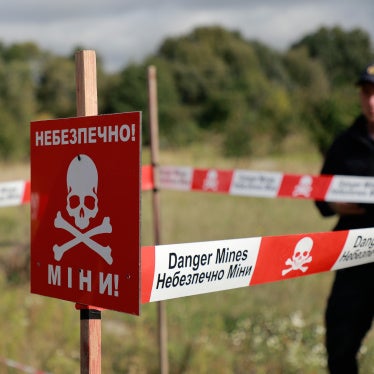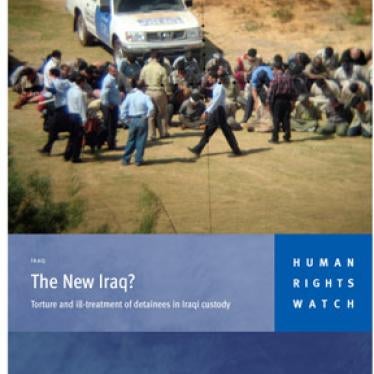Tens of thousands of civilians are killed and injured every year from the use in populated areas of explosive weapons, such as mortars, rockets, artillery projectiles, and aircraft bombs, including barrel bombs. As civilian casualties multiply, international efforts to deal with this problem are gathering pace. The United Nations secretary-general, several UN agencies—notably the Office for the Coordination of Humanitarian Affairs (OCHA)—and the International Committee of the Red Cross (ICRC) have all acknowledged the need to address the civilian harm caused by the use of explosive weapons with wide area effects in populated areas.See, e.g., UN Secretary-General, “Report of the Secretary General on the protection of civilians in armed conflict,” S/2012/376, May 22, 2012, para. 75; UN Secretary-General, “Report of the Secretary General on the protection of civilians in armed conflict,” S/2013/689, November 22, 2013, para. 34; UN Office for the Coordination of Humanitarian Affairs (OCHA), “Explosive weapons in populated areas,” November 25, 2013, http://www.unocha.org/top-stories/all-stories/humanitarian-issues-strengthening-protection-explosive-weapons (accessed April 28 2015); Statement by International Committee of the Red Cross (ICRC), UN General Assembly First Committee, General debate on all disarmament and international security agenda items, New York, October 14, 2014, https://www.icrc.org/en/document/weapons-icrc-statement-united-nations-2014 (accessed April 28, 2015). States are also seeking to find ways to protect civilians from this threat. In September 2015, Austria will host a meeting to consider how to strengthen the protection of civilians from explosive weapons used in populated areas. The initiative follows a meeting hosted by Norway in 2014 on the same topic. As momentum for international action grows, calls for a political commitment to prevent harm from explosive weapons are increasing.
This paper aims to inform discussions on a political commitment to protect civilians from explosive weapons. It outlines options for the form and nature of such a commitment, for its development and endorsement, and for mechanisms for review, reporting, and institutionalization. By setting out a range of precedents, the paper provides different models on which a political commitment on explosive weapons could draw, either separately or in combination. The precedents also demonstrate the feasibility of such a political commitment. With political will, creative vision, and recognition of the urgency of the problem, a commitment to limit the harm caused by explosive weapons to civilians could be produced in a timely fashion.
The use of explosive weapons in populated areas destroys civilian lives and infrastructure. According to one source, nearly 38,000 people were killed or injured by explosive weapons in 2013 alone.Action on Armed Violence, “Explosive Events: Monitoring Explosive Violence in 2013,” April 2014, http://aoav.org.uk/wp-content/uploads/2014/05/AOAV-Explosive-Events-2013.pdf (accessed April 15, 2015), p. 3. In populated areas, such as cities and towns, the proportion of civilian casualties was 93 percent.Ibid. Explosive weapons with wide area effects pose especially grave danger. They encompass weapons that produce a large blast and/or fragmentation radius (such as aircraft bombs); weapons that deliver multiple munitions that saturate a large area (such as Grad rockets and others from multi-barrel rocket launchers); and weapons that are so inaccurate that they cannot be effectively targeted (such as barrel bombs). Using explosive weapons with these characteristics in cities and towns inevitably causes immense harm to civilians.
Human Rights Watch and the International Human Rights Clinic at Harvard Law School (IHRC) welcome the increased international attention being paid to the civilian harm caused by the use of explosive weapons in populated areas and urge states to pursue a political commitment to limit that harm. Human Rights Watch is a founding member of the International Network on Explosive Weapons (INEW), a global coalition of nongovernmental organizations (NGOs) that calls on governments to “develop stronger international standards, including certain prohibitions and restrictions on the use of explosive weapons in populated areas.”“INEW: Learn More,” International Network on Explosive Weapons, accessed April 5, 2015, http://www.inew.org/learn-more-about-inew. INEW and its member organizations are prepared to work with states, the United Nations, and the ICRC to help create such standards in the form of a political commitment. Civil society has played an active role in the development of recent humanitarian disarmament instruments and should be a significant contributor in this newest effort to reduce harm to civilians from certain weapons.
This paper provides a roadmap of the paths a political commitment (or series of commitments) on explosive weapons could take. It first identifies four types of commitments—declarations, regulations, guidelines, and manuals—which are distinguishable by form and nature. The paper then explains processes for the development and endorsement of these commitments, which can be led by states, a partnership of states, NGOs, and international organizations, or UN bodies. Finally, it examines mechanisms, notably for reporting and review, to promote implementation of commitments. This paper notes some advantages and disadvantages of each option in the context of explosive weapons, although it does so without providing an in-depth critique. That approach is not meant to imply that all options are equally attractive. Instead it aims to ensure that decisions are based on a comprehensive understanding of the different routes that could be pursued.
In this paper, a “political commitment” is a written document that outlines standards for state conduct; states may endorse a commitment, but they understand that it is not legally binding. A treaty, by contrast, is a written agreement between two or more states; through certain procedural steps, states consent to be legally bound by a treaty’s terms.See Vienna Convention on the Law of Treaties, adopted May 22, 1969, 1155 UNTS, entered into force January 27, 1980, art 2(1)(a). The paper’s analysis draws on 30 political commitments, dating back to 1979, that are related to armed conflict, armed violence, or arms control. They deal with such topics as the protection of schools from military use during armed conflict, the regulation of private military and security companies, and the prevention of ballistic missile proliferation.The paper does not cover all political commitments in these areas. The 30 commitments analyzed represent the most prominent examples.
Political commitments have a long history of setting standards for conduct in armed conflict. The 1863 founding conference of the Red Cross movement, attended by representatives of sixteen states and four philanthropic institutions, issued a series of recommendations to states, including the now widely accepted principle that warring parties should recognize the neutrality of the Red Cross.Resolutions of the Geneva International Conference, October 26-29, 1863, https://www.icrc.org/applic/ihl/ihl.nsf/Article.xsp?action=openDocument&documentId=0E0385578E11B4ABC12563CD005152EB (accessed April 5, 2015), recommendations. The 1880 Oxford Manual, authored by the Institute for International Law, was another early effort to provide guidance for states on conduct in war that set standards reflected in subsequent international treaties.Institute of International Law, The Laws of War on Land (Oxford Manual), September 1880, https://www.icrc.org/ihl/INTRO/140?OpenDocument (accessed April 5, 2015). Such precedents show the powerful normative effect that political commitments can have over time. A commitment to curb the use of explosive weapons with wide area effects in populated areas would continue this tradition and help build consensus on the best means to prevent harm to civilians.








